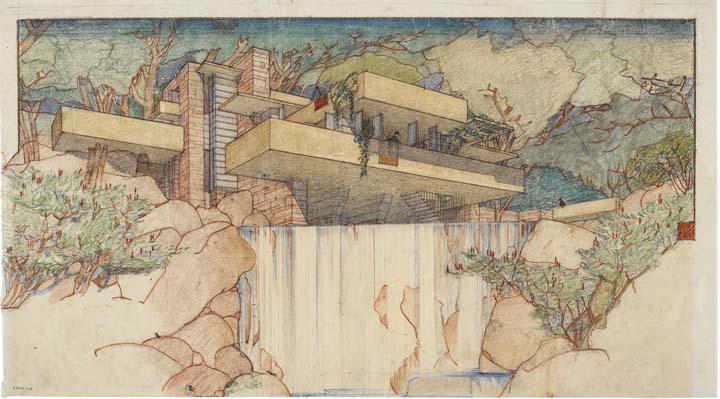Frank Lloyd Wright at MoMA
Frank Lloyd Wright, visionary designer, intellectual, and educator, was one of the most important architects of the 20th century, whose influence is still felt today. Of the more than 1,000 projects he designed, over 500 were realized—and it was not just the buildings, but usually their interior design, and very often, furniture, textiles, ornamental design, with dinnerware and objects to complete the architect’s vision for his clients.
Wright’s prolific career is now being celebrated in an exhibition at the Museum of Modern Art. Frank Lloyd Wright at 150: Unpacking the Archive marks the anniversary of his birth on June 8, 1867, presenting 450 works made from the 1890s through the 1950s, including works in various media that demonstrate the depth and scope of his practice.
While Wright had the reputation of being anti-urbanist, he was worldly, and obsessed with technology and systems—he designed many skyscrapers, hotels, and corporate headquarters. Some of Wright’s most compelling projects, however, were envisioned for ordinary people. The heart and soul of his creative expression sprang from the prairie, and his life-long concern was the family home, for both wealthy and middle-class clients. In his search to realize comfortable, affordable homes, he banished formal spaces that relied on hired help to keep them running smoothly. Among the innovative layouts he introduced were the “pass-through kitchen,” which enabled the homemaker to remain involved with the family as meals were prepared, as well as built-in furniture and storage.
Frank Lloyd Wright (American, 1867–1959). Jacobs House, Madison, Wisconsin. 1936–37.
Exterior perspectives. Colored pencil on paper, detail. The Frank Lloyd Wright Foundation Archives (The Museum of Modern Art | Avery Architectural & Fine Arts Library, Columbia University, New
York). This was the first of Wright's Usonian Homes.
The Usonian House, a project that occupied his thoughts and the work of his studio from the 1930s to the late ‘50s, was intended to be, in part, a do-it-yourself-er—a radical idea at the time, which was also the period of the Great Depression: it was a way of cutting costs. Each house was tailored to the client’s needs, but based on a system Wright had developed to keep his fees moderate. His compact, no-frills—but highly articulated—suburban houses, characterized by native materials like local stone and wood, denied wasted space. From that concern arose the covered parking spot, which Wright named the “carport.” Thus was born the suburban “ranch house,” which in ordinary hands became those “little boxes on the hillside.”
Around 1932, inspired by President Roosevelt’s New Deal programs, Wright designed several experimental farms utilizing back-to-the-land strategies that were the precursor of today’s farm-to-market trend, with the goal of allowing people to live independent, productive lives. The "Little Farms Unit" projects later morphed into Broadacre City, a utopian melding of rural/urban environments that paralleled the Ville Radieuse of Le Corbusier, but decidedly rooted in Wright's prairie aesthetic.
Frank Lloyd Wright (American, 1867–1959).
Fallingwater (Kaufmann House), Mill Run, Pennsylvania. 1934–37. Perspective from the south. Pencil and colored pencil on paper, detail. The Frank Lloyd Wright Foundation Archives (The Museum of
Modern Art | Avery Architectural & Fine Arts Library, Columbia University, New York). One of Wright’s most lauded designs, this house is an elaboration of core ideas expressed
in the Usonian houses for a wealthy client.
Although Wright’s designs were imbued with the demands of modern life, his office, or “studio,” operated on a traditional European atelier system. Staffed by loyal apprentices, many of whom were devotees who stayed on for years beyond their training period, the Taliesen Fellowship, as it was known, enabled the master to ensure that every small detail and every material transformation was studied from every possible angle until it acquired the finish and perfection he demanded. It also enabled him to maintain a style of drawing, model building and presentation that became the unmistakable signature of Taliesen.
Frank Lloyd Wright (American, 1867–1959). Plan for Greater Baghdad, Baghdad. Project, 1957.
Aerial perspective of the cultural center and University from the north. Ink, pencil, and colored pencil on tracing paper, detail. Frank Lloyd Wright Foundation Archives (The Museum of Modern Art |
Avery Architectural & Fine Arts Library, Columbia University, New York)
While the exhibition might seem, on the surface, to be meant primarily for architects and scholars, there is much to be gained from looking at the drawings and objects in terms of their intended production. In doing so, the abstract nature of two-dimensional drawings, and miniature cardboard models of houses, cities, and environments seems to melt away, revealing the majesty of Wright’s vision. To further the exhibition's takeaway, MoMA has created a series of public programs that includes The People’s Studio: Design, Experiment, Build. Visitors are invited to think like designers and explore architecture through “themes connected to community, nature, and the integration of art and daily life.” Info
Frank Lloyd Wright at 150: Unpacking the Archive continues through October 1 at the Museum of Modern Art, 11 West 53rd Street, NY, NY Info
Frank Lloyd Wright at 150: Unpacking the Archive is organized by The Museum of Modern Art, New York, and Avery Architectural & Fine Arts Library, Columbia University. Organized by Barry Bergdoll, Curator, Department of Architecture and Design, The Museum of Modern Art, and the Meyer Schapiro Professor of Art History and Archaeology, Columbia University; with Jennifer Gray, Project Research Assistant, Department of Architecture and Design, The Museum of Modern Art.





